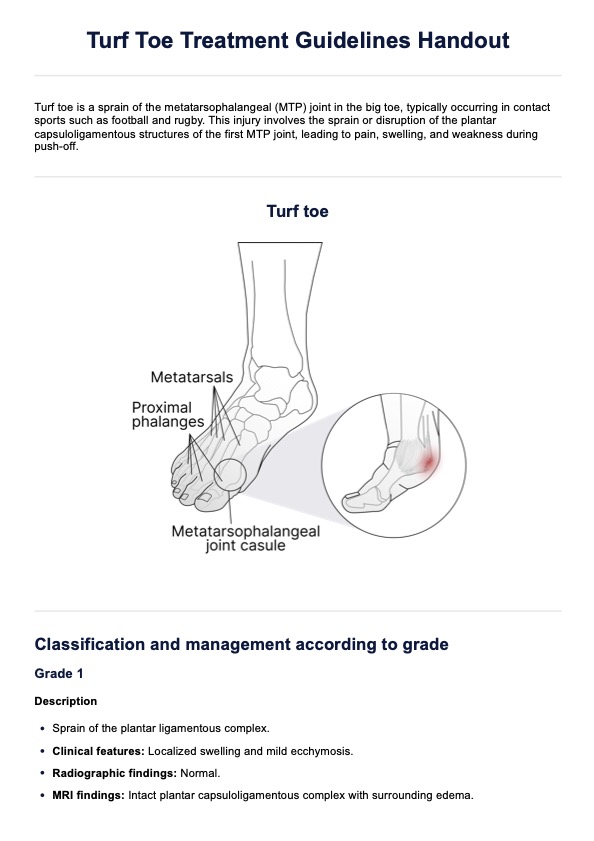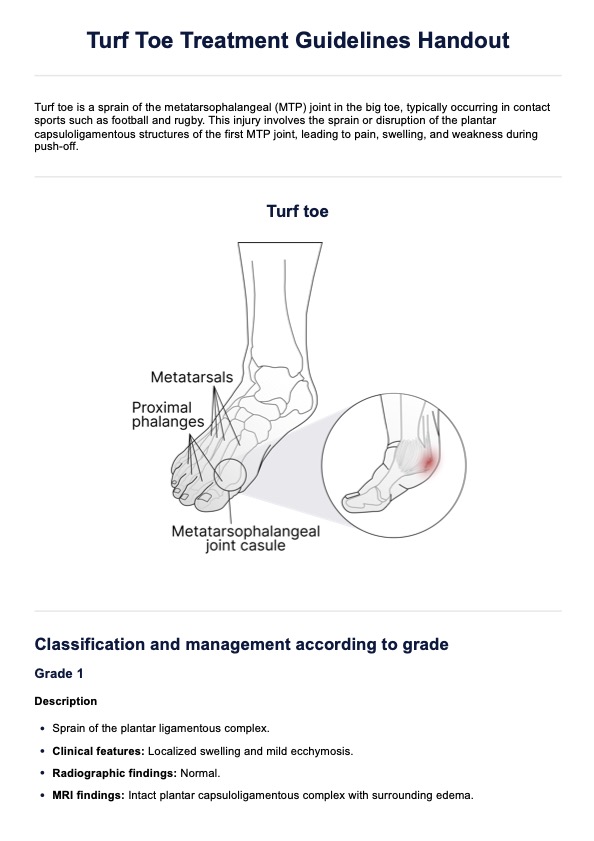Turf Toe Treatment Guidelines Handout
Learn the most effective treatment guidelines for turf toe with Carepatron's free PDF download. Get tips to effectively treat this common sports injury.


What is turf toe?
Turf toe is a common sports injury that affects the big toe's metatarsophalangeal joint, where the toe meets the foot. It typically occurs when the toe is forcefully bent upwards, such as during a sudden stop or push-off on hard surfaces like artificial turf. This condition, known as a turf toe injury, involves damage to the soft tissue and ligaments around the toe joint, leading to pain and swelling.
Common turf toe symptoms include pain, swelling, and limited range of motion in the big toe. These symptoms of turf toe can make it difficult to walk or perform athletic activities. The injury often results from repetitive stress or a single, traumatic event where the toe joint is hyperextended.
Preventing turf toe involves wearing appropriate footwear and using supportive insoles, especially when playing on artificial turf. Strengthening exercises and proper warm-ups can also help prevent turf toe injuries by enhancing the stability and flexibility of the toe joint.
Turf Toe Treatment Guidelines Handout Template
Turf Toe Treatment Guidelines Handout Example
Turf toe treatments
Turf toe is a painful condition that requires proper treatment to ensure a full recovery and prevent further injury. Depending on the severity of the turf toe injury, different treatments may be recommended. Here, we discuss the most effective methods to treat turf toe and manage its symptoms.
Rest and immobilization
The first step in treating turf toe is often rest and immobilization. When a turf toe injury occurs, it is crucial to avoid activities that can worsen the condition. Resting the injured foot and keeping weight off the big toe joint can help reduce pain and inflammation. In some cases, a walking boot may be used to immobilize the toe and allow the metatarsophalangeal joint to heal. Grade 1 injuries generally require 1-2 weeks of rest, while Grade 2 injuries may need 4-6 weeks. Grade 3 injuries might necessitate immobilization for up to 8 weeks or more, followed by gradual return to activities.
Ice and compression
Ice and compression are standard treatments to manage the symptoms of turf toe. Applying ice to the injured foot can help reduce swelling and alleviate pain. Using a compression bandage can also minimize swelling by preventing fluid buildup in the affected area. These methods are best applied immediately after the injury occurred and continued for two to three weeks as needed.
Physical therapy
Physical therapy plays a significant role in the recovery process for turf toe. A physical therapist can design a rehabilitation program that includes exercises to improve the range of motion and strengthen the muscles around the big toe joint. This can help restore function and prevent future injuries. Physical therapy is especially important for athletes and individuals with more severe injuries who require a structured recovery plan.
Medication and pain management
Over-the-counter pain relievers such as ibuprofen can help manage pain and reduce inflammation associated with turf toe. In more severe cases, a doctor specializing in sports medicine may prescribe stronger medications to alleviate pain and assist with recovery. Anti-inflammatory medications can be particularly helpful in managing swelling and pain in the early stages of the injury.
Surgery
Surgery is rarely needed but may be considered for severe injuries or cases where other treatments have failed. Surgical intervention aims to repair the damaged ligaments and soft tissue around the metatarsal bone and the MTP joint, ensuring the big toe can function correctly. Indications for surgery include large capsular avulsion with joint instability, retraction of sesamoids, sesamoid fracture, traumatic hallux valgus deformity, chondral injury, cock-up toe deformity, intra-articular loose body, and failure of conservative management. Post-surgery, a period of immobilization and physical therapy will be necessary to regain full range of motion.
Preventive measures
Preventing turf toe involves wearing appropriate footwear, particularly when playing on artificial turf. Athletes should wear shoes with proper support and cushioning to protect the big toe joint. Strengthening and flexibility exercises can also help maintain the stability of the toe joint, reducing the risk of injury. Ensuring proper warm-up before activities and avoiding sudden changes in direction or excessive push-off movements can also help prevent turf toe.
How to use our treatment guidelines handout template?
Carepatron's Turf Toe Treatment Guidelines Handout is designed to assist medical professionals in providing comprehensive care to patients with turf toe injuries. This easy-to-use template ensures that patients receive clear, concise information about their condition and treatment plan.
Step 1: Access and download the template
Medical professionals can access and download the template via the Carepatron app or the download link below.
Step 2: Introduce the handout to the patient
When introducing the handout to the patient, explain its purpose and how it will assist in their recovery. Highlight key sections such as treatment steps, recommended exercises, and preventive measures to ensure the patient understands how to use the handout effectively.
Step 3: Educate the patient
Use the handout as an educational tool to guide the patient through their treatment plan. Review the information together, addressing any questions or concerns they may have. This ensures that the patient is well-informed and actively involved in their recovery process.
How can healthcare professionals benefit from our template?
Healthcare professionals can greatly benefit from Carepatron's Turf Toe Treatment Handout template by streamlining patient education and treatment planning. The template provides a structured and comprehensive approach to managing turf toe, saving time and ensuring consistency in care. Through this handout, professionals can easily communicate complex information in an understandable manner, enhancing patient compliance and engagement. It includes detailed steps for treatment, exercises, and preventive measures, allowing professionals to focus more on patient interaction and less on documentation.
Additionally, the template can be customized to fit individual patient needs, making it a versatile tool in any medical practice. Ultimately, our template supports efficient and effective patient management, leading to improved recovery outcomes and higher patient satisfaction.
Commonly asked questions
The fastest way to cure turf toe involves rest, ice, compression, and elevation (RICE) combined with physical therapy to improve range of motion and strengthen the big toe joint. Severe cases may require a walking boot and more extended rest periods.
Walking on turf toe should be minimized to prevent further injury and allow healing. Use supportive footwear and follow a physical therapist's recommendations for safe movement.
Wearing a walking boot for turf toe can help immobilize the joint and promote healing, especially in more severe cases. Consult with a healthcare professional to determine if a boot is necessary for your specific injury.
Gentle massage can help reduce swelling and improve circulation in turf toe, but it should be done carefully to avoid aggravating the injury. Always consult with a healthcare professional before starting any new treatment.







































































































